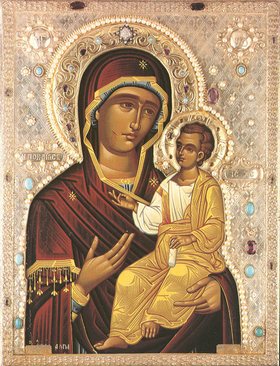
Mother of God

Theotokos (/ˌθiːəˈtoʊkoʊs, ˌθeɪə–, –ˈtɒ–, –kəs/;Greek: Θεοτόκος, transliterated (Greek) Theotókos, translation (Syriac-Aramaic): ܝܳܠܕܰܬ ܐܰܠܳܗܳܐ, transliterated (Syriac): Yoldath Alloho) is the Greek title of Mary, the mother of Jesus used especially in the Eastern Orthodox, Oriental Orthodox, and Eastern Catholic Churches. Its literal English translations include “God-bearer”, “Birth-Giver of God” and “the one who gives birth to God.” Less accurate translations include the primarily Western title “Mother of God” (Latin: Mater Dei).
The ancient use of this term is emphasised in Churches of the Syriac Tradition, which have been using this title in their ancient liturgies for centuries: the Anaphora of Mari and Addai (3rd Century), and the Liturgy of St James the Just (4th Century).[5][6] The Council of Ephesus decreed in 431 that Mary is Theotokos because her son Jesus is both God and man: one Divine Person with two natures (Divine and human) intimately, hypostatically united.[7][8]
Roman Catholics and Anglicans use the title “Mother of God” more often than “Theotokos“. Lutherans also venerated and honored Mary as “Mother of God” as expressed by its founder, Martin Luther;
Theotokos is a compound of two Greek words, Θεός God and τόκος parturition, childbirth. Literally, this translates as God-bearer or the one who gives birth to God; historian Jaroslav Pelikan translated it more precisely as “the one who gives birth to the one who is God”.[12] However, since many English-speaking Orthodox find this literal translation awkward, in liturgical use, Theotokos is often left untranslated, or paraphrased as Mother of God. The latter title is the literal translation of a distinct title in Greek, Μήτηρ του Θεού (translit. Mētēr tou Theou). Mother of God also accurately translates the Greek words Θεομήτωρ (translit. Theomētor; also spelled Θεομήτηρ, translit. Theomētēr) and Μητρόθεος (translit. Mētrotheos), which are found in patristic and liturgical texts.[13][14]
The English term Mother of God is mostly used as an imprecise translation of Theotokos, but with a note that Mary did not create the divine person of Jesus, who existed with the Father from all eternity,[15] she is not the source of her Son’s divinity.[16] The other principal use of Mother of God has been as the precise and literal translation of Μήτηρ Θεού, a Greek term which has an established usage of its own in traditional Orthodox and Catholic theological writing, hymnography, and iconography. In an abbreviated form, ΜΡ ΘΥ, it often is found on Eastern icons (see illustration above), where it is used to identify Mary.
Within the Orthodox and Catholic tradition, Mother of God has not been understood, nor been intended to be understood, as referring to Mary as Mother of God from eternity — that is, as Mother of God the Father — but only with reference to the birth of Jesus, that is, the Incarnation. This limitation in the meaning of Mother of God must be understood by the person employing the term. To make it explicit, it is sometimes translated Mother of God Incarnate.[17]
However, those reading or hearing the English phrase Mother of God as a translation of a Greek text cannot — unless they know the Greek text in question, or obtain additional information — know whether the phrase is a literal translation of Μήτηρ Θεού, or an imprecise rendering of Θεοτόκος, or one its Latin equivalents or equivalents in other languages. On the other hand, Theotokos and its precise translations explicitly relate Mary’s motherhood to Jesus’ birth in time and exclude any reference to Mary as Mother of God from eternity.